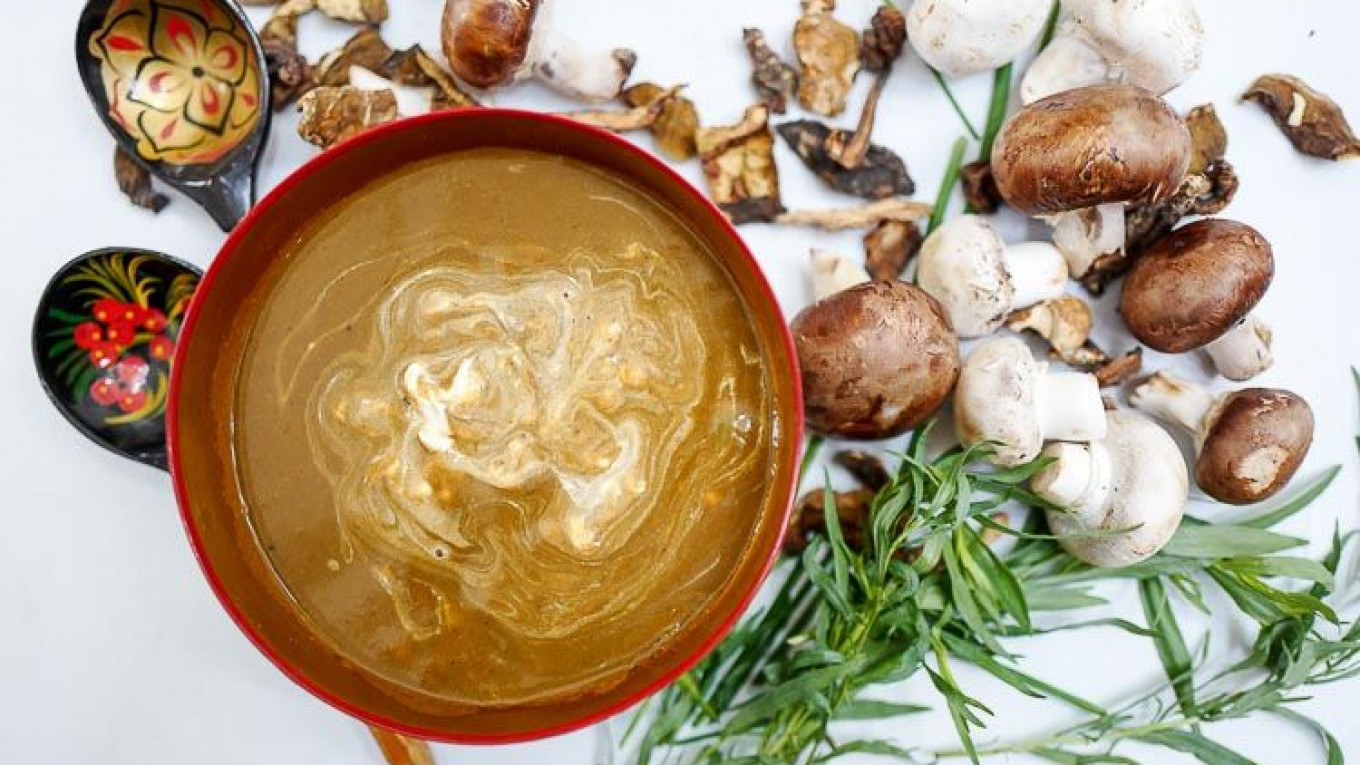The time has come to speak about Russia’s true national sport.
Forget football, disregard hockey, and abandon judo; the season of “tikhaya okhota” or silent hunt is upon us, when stalkers armed with long sticks and bark and twig “lukoshki” baskets set out through misty mornings to run their quarry to ground in the damp undergrowth of Russia’s forests. This is mushroom hunting, a national pastime — dare one call it a passion — which grips Russians from late August and holds them in its grip until well into October. As the days shorten, you can see them in the inky evening twilight; young and old, men and women, city slickers and country mice in subway cars or on suburban railway platforms, a tad grimy, certainly weary, but utterly content, clutching their trophies of lukoshki filled with dirt-flaked chanterelles, white button mushrooms, and milk caps.
It is hard to convey the scope and intensity of this national frenzy of fungi hunting to one who has not sallied forth with a band of seasoned veterans on a damp Saturday morning in mid-September. There is the initial uncertainty — skepticism even, followed by the surge of excitement at the first sighting of a smooth beige cap half hiding under a bed of dead leaves and pine needles. From there, the day unfolds in a mesmerizing progression, as the chase lures you deeper and deeper into the forest, your eyes glued to the base of trees or the dark shadows of fallen logs. And at the end, the quiet triumph of the successful forager who has gleaned a basket of the aromatic bounty of the deep woods. Once experienced, the silent hunt becomes a lifelong addiction.
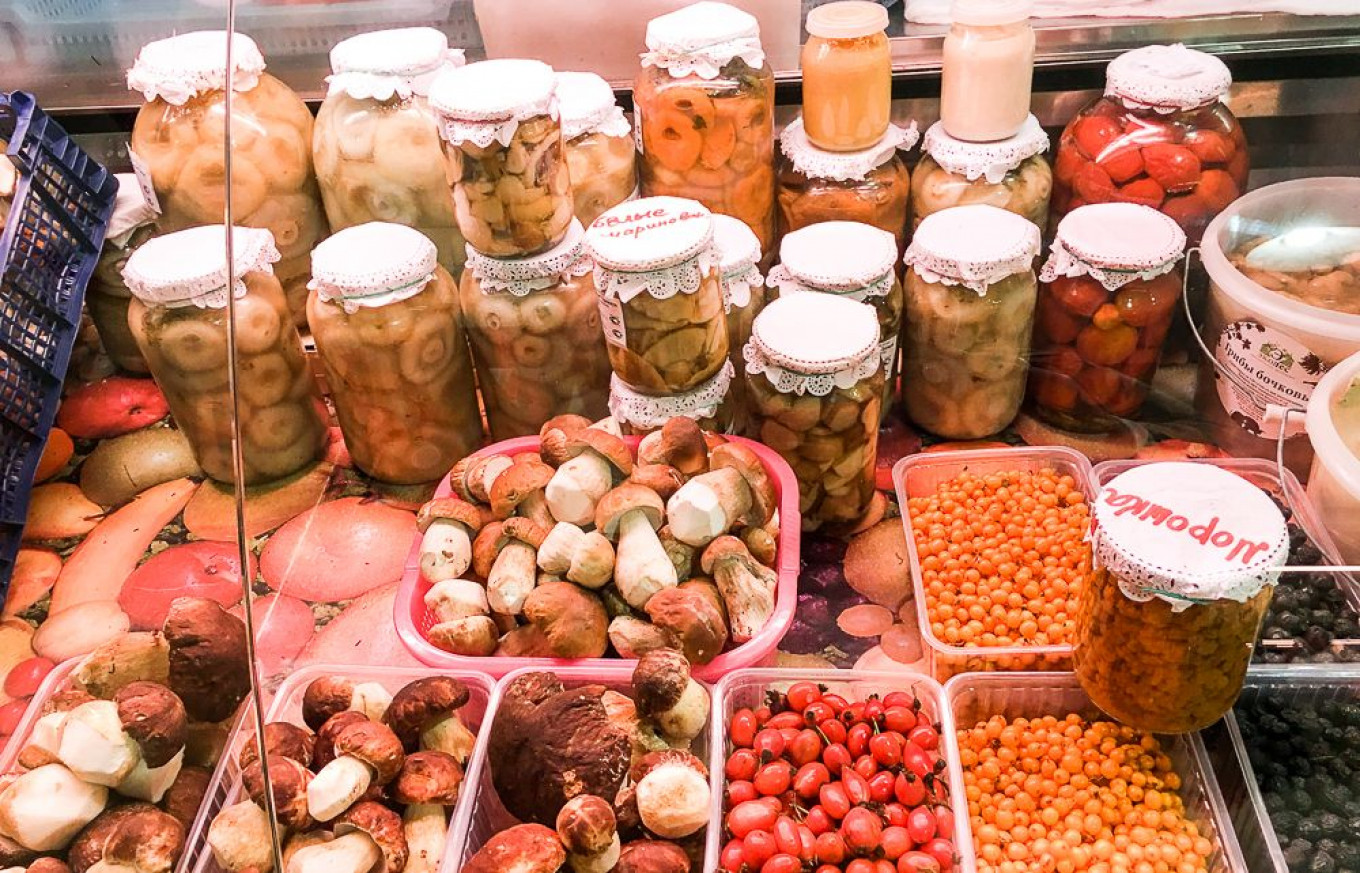
In “Speak Memory,” Nabokov evokes “that special boletic reek which makes a Russian’s nostrils dilate–a dark, dank, satisfying blend of damp moss, rich earth, rotting leaves.” Nabokov’s own mother was a passionate mycophile, whose “main delight was in the quest… As she came nearer from under the dripping trees and caught sight of me, her face would show an odd, cheerless expression, which might have spelled poor luck, but which I knew was the tense, jealously contained beatitude of the successful hunter.”
The thrill of the chase provided ample adrenaline for the aristocrats of Imperial Russia. As Nabokov observed, at the end of a successful day’s hunting, his mother’s mushrooms were “… bundled away by a servant to a place she knew nothing about, to a doom that did not interest her.” But for the poorer folk of Russia — the peasants and serfs — a more urgent and fundamental survival instinct prompted the search for mushrooms. Imperial law mandated that serfs till the soil of their masters or render to them a portion of their harvest as rent, but by ancient custom, the fruits of the forest were theirs for the keeping, including nuts, berries, and mushrooms. Dried or salted mushrooms helped to stretch and supplement the peasants’ meager winter diet, and were doubly welcome in the final weeks, when the storerooms were bare, and the spartan Lenten fast prohibited meat or fish.
Unlike most ingredients in Russian cuisine, mushrooms tend not to stay in one lane, but appear in many different iterations: as the opening salvo of a dinner in the zakuska pickle platter, or they arrive to the table with the fanfare due a hot appetizer, a piping julienne of mushrooms, sour cream and cheese. Mushrooms bob happily in many Russian soups, and glisten in the rich dishes of the nineteenth century, such as Beef Stroganoff and Veal Orlov. But mushrooms are also key ingredients in simpler, more basic fare, and many of Russia’s most cherished “comfort” dishes: potatoes fried with mushrooms and onions, mushroom and buckwheat kasha, mushroom pastries, and mushroom pelmeni.
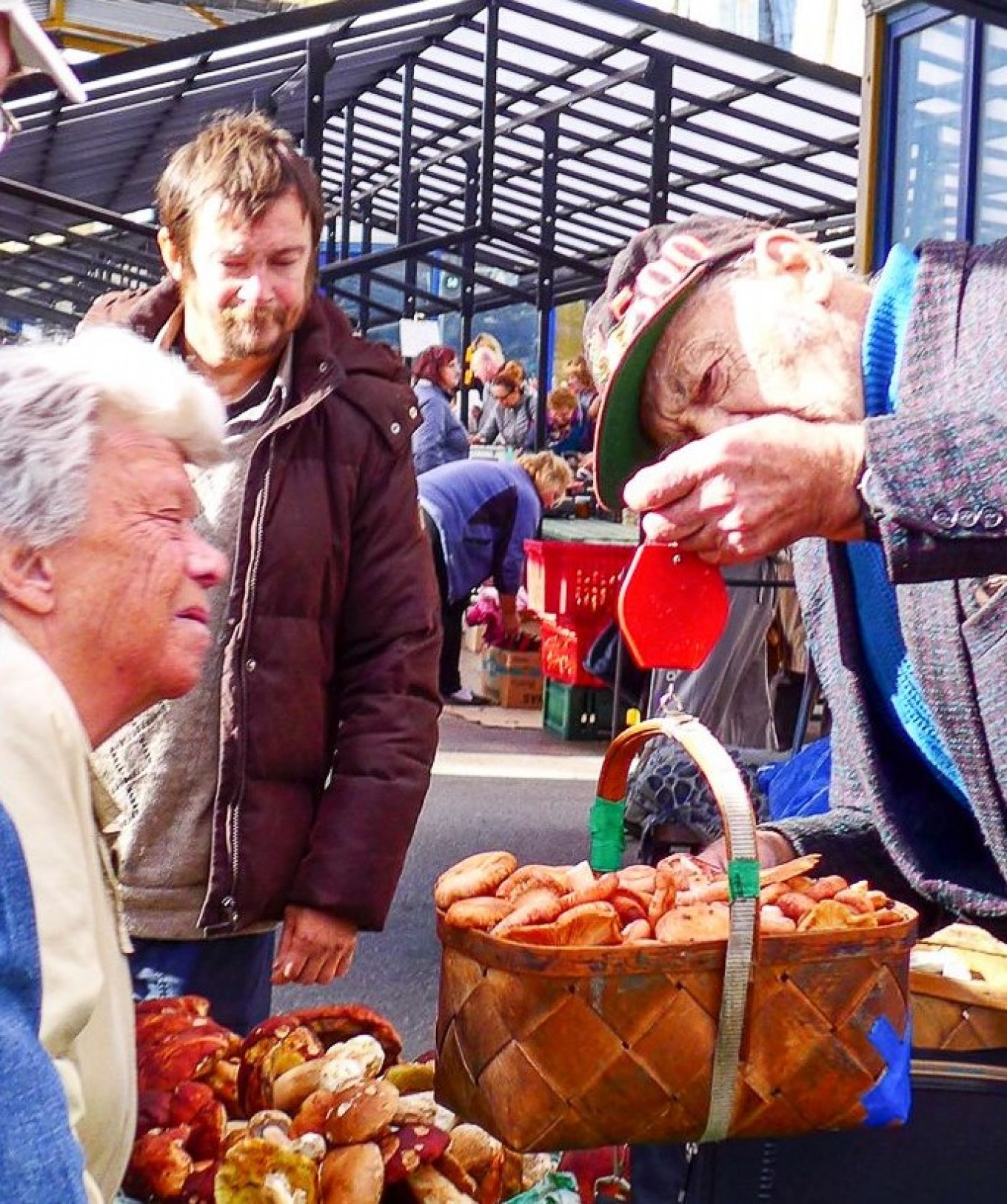
If you can’t get to a Russian forest to go mushroom hunting, do the next best thing and head to a farmer’s market, where for the next few weeks, mushrooms will be front and center in all their many forms: salted and pickled in glittering jars, dried on long strings, or piled high, freshly foraged, dirt still clinging to them. Clean fresh mushrooms by removing the tough stalks (save these for stock) and gently rinsing them in a colander, then lay them out on a clean cloth to dry. To rehydrate dried mushrooms, submerge them in a bath of boiling water for at least 30 minutes.
Any mushroom dish will benefit from including rehydrated mushrooms, which have a concentrated flavor. This is particularly true for mushroom soups, which are my favorite way to capture and enjoy this seasonal bounty of the forest. Below are three of my favorite recipes, which I’ve developed and honed during many a “tikhaya okhota” season.
IMPORTANT NOTE: Foraging for mushrooms is a marvelous sport and quintessential Russian cultural touchstone, but one that can end in tragedy if you don’t know your edible fungi from the poisonous ones. If you are a neophyte, don’t go it alone — try to find a group of experienced mushroom hunters to take you along on a day’s hunting, or join a group outing led by a professional botanist.
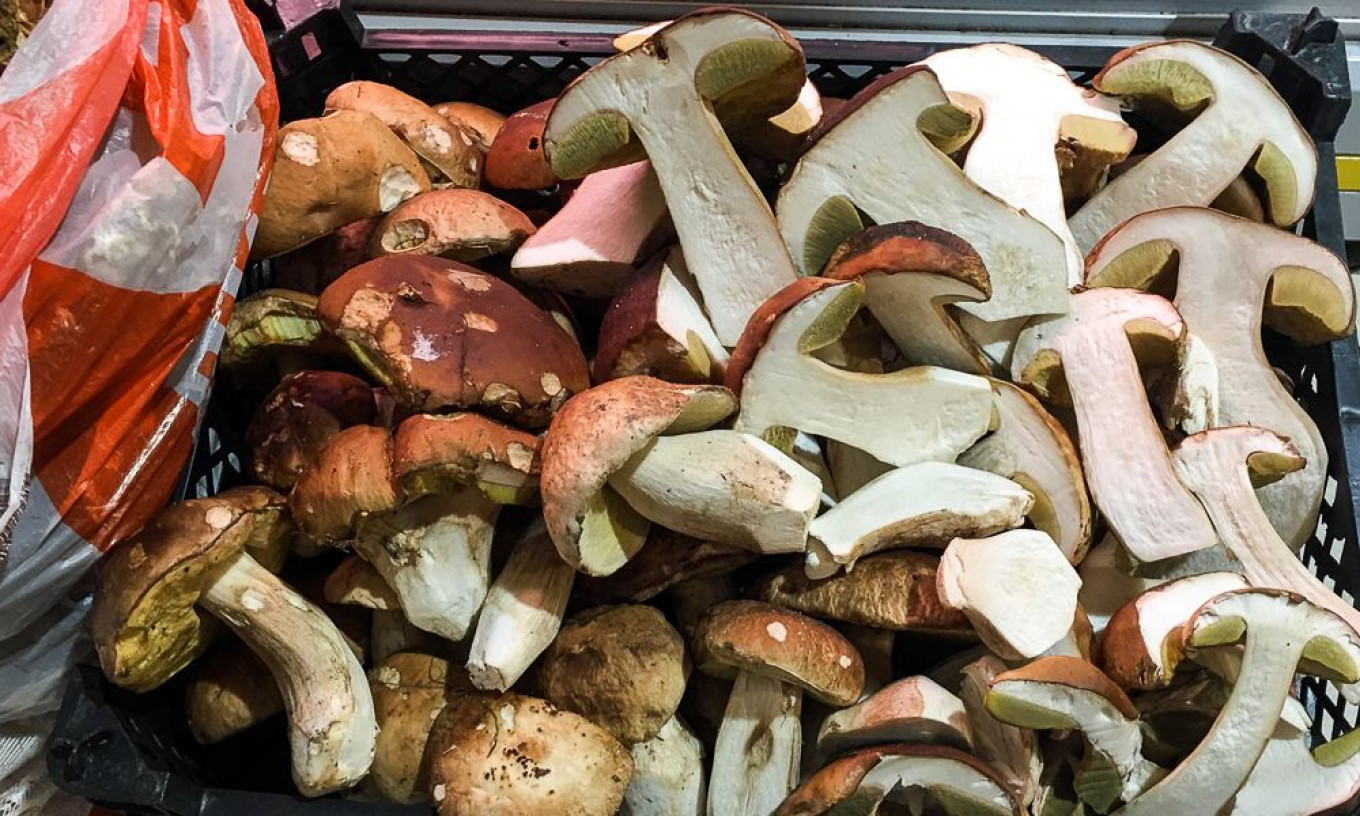
Mushroom Stock
When mushroom season is in full throttle, my freezer stock bag fills up with the tails and woody stalks of fresh mushrooms and the tough stems of dried mushrooms. Well-rinsed, these add a great deal of flavor to the recipe below, which you can freeze in small amounts to add to risottos, soups, sauces, or broths.
Ingredients
- 2 quarts (2 liters) cool water
- 1 quart (1 liter) boiling water
- 2 cups (480 ml) dried mushrooms
- ½ cup (125 ml) Madeira or dry sherry
- 1 carrot peeled and roughly chopped
- 6 whole cloves
- 2 Tbsp tomato paste
- 8 chicken wings
- Olive oil
- Salt and pepper to taste
- 2 Tbsp soy sauce
- 2 bay leaves
- 3-4 sprigs thyme
- 1 yellow onion, roughly chopped — include the skin if it is clean as this adds to the golden color of the broth
- Any mushroom tails, stalks, and stems you have accumulated.
Instructions
- Pre-heat the oven to 400ºF (210ºC) and select the “roast” function if you have it.
- Toss the chicken wings, carrots, onion, cloves, and olive oil together in a shallow roasting pan and sprinkle generously with salt. Roast for 40 minutes or until the wings are golden brown.
- Place the roasting pan over medium heat and deglaze the pan with the Madeira, using the back of a wooden spoon to scrape up all the little bits that are clinging to the bottom of the pan. When you have scraped up these, add the tomato paste and soy sauce and let the liquids come to a gentle simmer. Cook for an additional 4-5 minutes until the liquids thicken.
- Transfer the contents of the roasting pan into a heavy-bottomed soup pot set over medium heat. Add the mushrooms, water, the bay leaves and thyme sprigs, and bring up to a simmer. Lower the heat and continue to simmer with the lid ajar for 2-3 hours.
- The rehydrated mushrooms will keep their texture and flavor, though the chicken wings won’t.
- Remove the mushrooms (and save for another purpose) and strain the broth through a fine-mesh sieve.
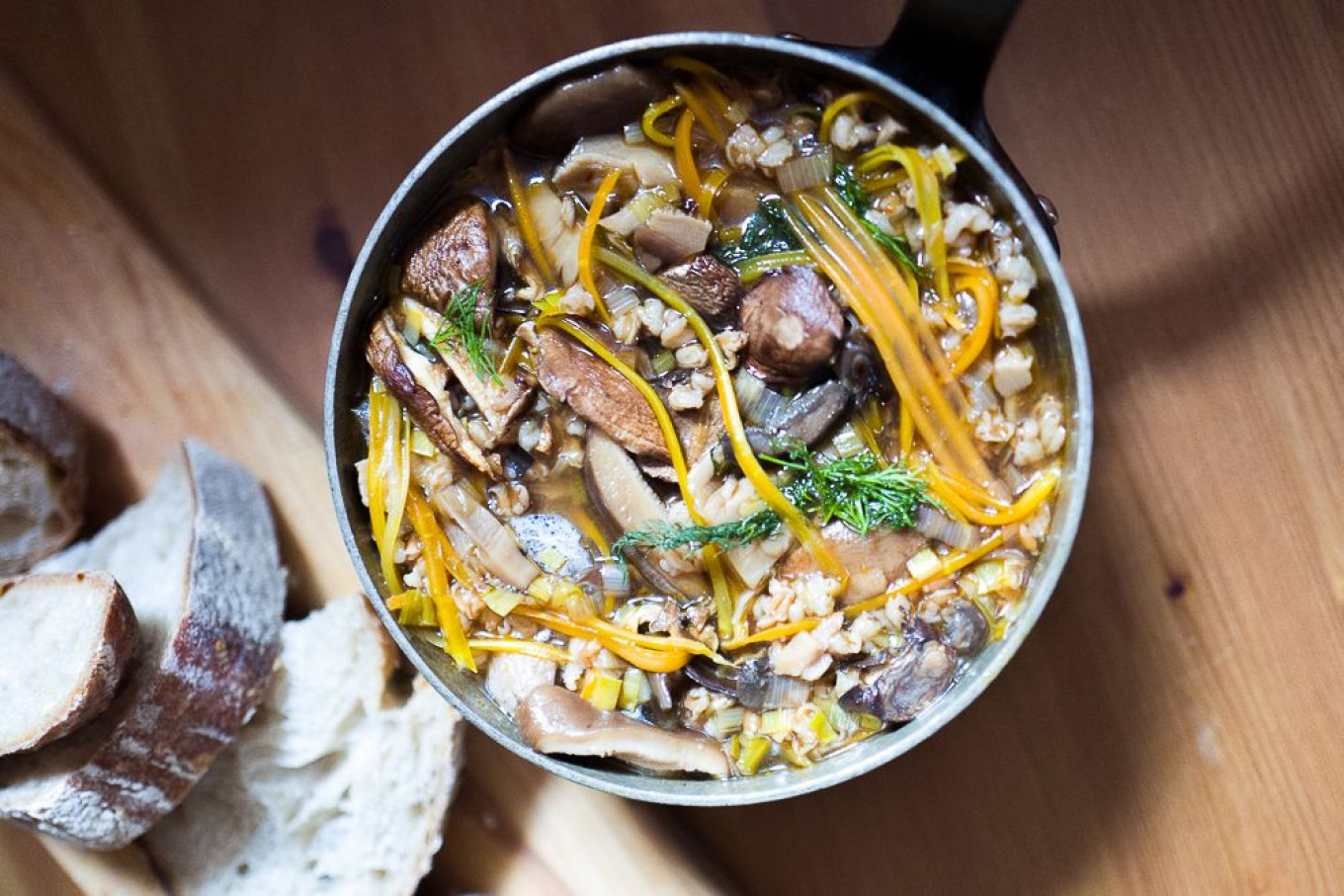
Wild Mushroom and Faro Pokhlebka
Pokhlebka is a marvelous umbrella term in Russian for “broth” or “stew” though my favorite way to translate it is the more antiquated “pottage.” This recipe is flexible and adaptable, with a base of dried and fresh wild mushrooms and faro — barley’s sexier Italian cousin. The result is a thick soup that verges on a stew. I often make this with a chicken or turkey carcass or a packet of smoked bacon ends, though it is a great vegetarian soup that needs only a generous dollop of sour cream and few thick slices of bread to turn into a meal.
Ingredients
- 3 quarts (3 liters) mushroom, vegetable, or chicken stock
- 3 cups (700 ml) fresh wild mushrooms, cleaned, trimmed, and cut into bite-sized pieces
- 2 cups (500 ml) dried mushrooms
- 1-½ cup (350 ml) faro, rinsed
- ½-cup (125 ml) Madeira or dry sherry
- 2 Tbsp olive oil
- 1 Tbsp of butter
- 1 large yellow onion, diced
- 3 carrots peeled and cut into matchsticks
- 1 bunch thyme, tied together with cooking string.
- 2 bay leaves
- 2 Tbsp tomato paste
- 2 Tbsp soy sauce
- 1 bunch fresh parsley, chopped
- Sour cream to garnish
Instructions
- Submerge the dried mushrooms into 1 quart of boiling water, cover, and set aside for at least 30 minutes.
- Working in batches, melt the butter in a large soup pot or Dutch oven. When it begins to foam, add the mushrooms in two separate batches and sauté until they leach liquid, then reabsorb it (about 12 - 15 minutes). Set the mushrooms aside, wipe out the pot.
- Heat the olive oil in the pot over medium heat, then sauté the onions until they are translucent. Add the carrots and rinsed faro and toss together. Add the tomato paste and toss until everything is coated. Lower the heat and cook for another two minutes, then add the Madeira and stir until they absorb the liquid.
- Strain the rehydrated mushrooms through a fine-mesh sieve, retaining the liquid. Rinse the mushrooms, then cut them to desired size and add them to the pot with their soaking liquid, the soy sauce, stock, and the cooked mushrooms. Stir to combine and let the soup come to a gentle simmer. Add the thyme to the pot, cover and cook for 45 minutes until the faro is done. Remove the Bay leaves and thyme before serving.
- Add the chopped parsley just before serving and add a dollop of sour cream and a drizzle of olive oil — truffle-flavored if you have it!
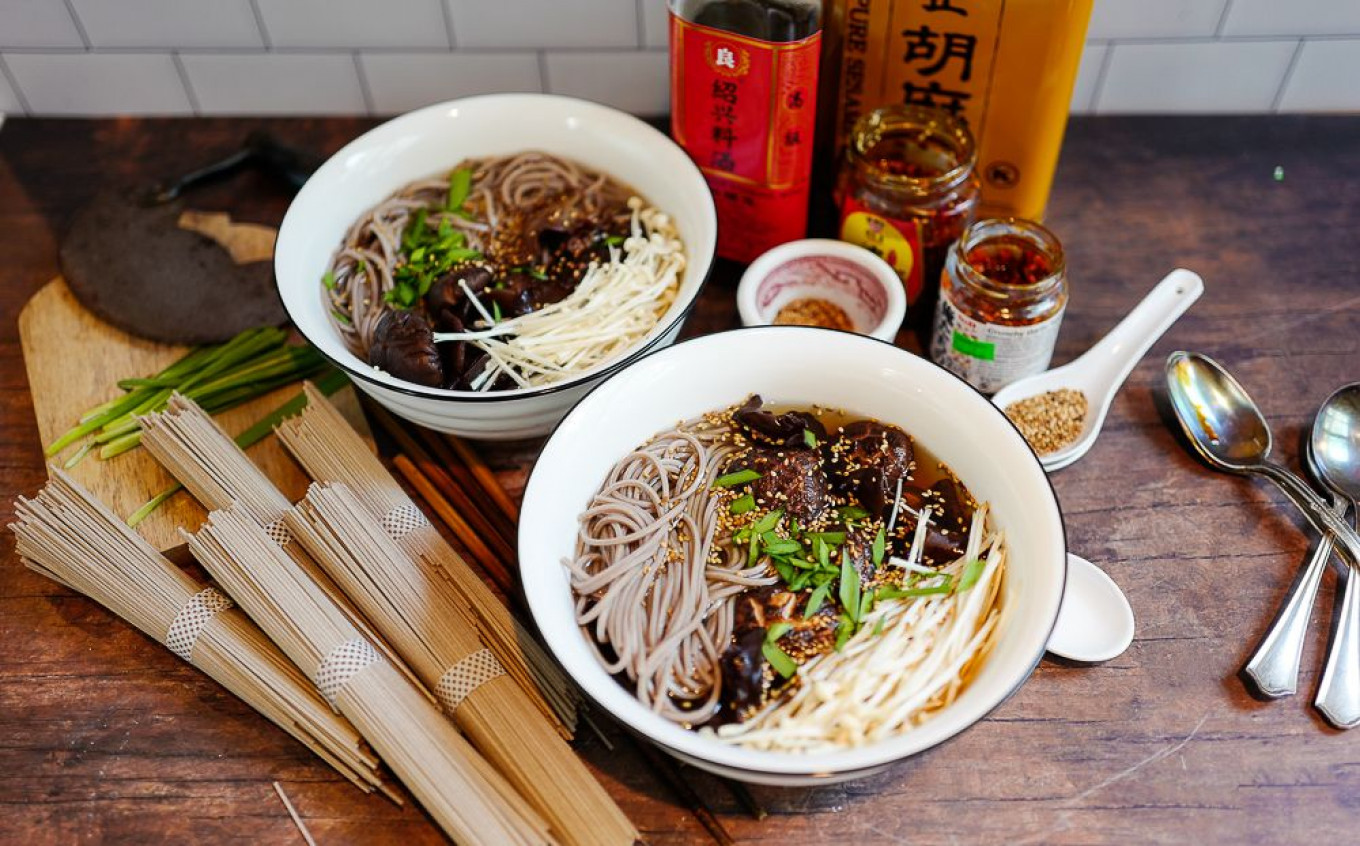
Russian Ramen
Noodle shops have roared into fashion in Russia — a delightful development for anyone who needs a cheap, hot, and nourishing pick-me-up. In honor of this happy addition to Moscow’s fast-food fare, here are two classic Russian flavors — mushrooms and buckwheat — brought together in a riff on the classic Russian “mushroom soup with noodles.” The addition of several Asian flavors and condiments takes this soup well beyond the Ural Mountains, and roasted mushrooms and buckwheat soba noodles turn it into an intense, broth-y, super-umami bowl of “Russian Ramen.”
I encourage you to experiment with this recipe and add any vegetables that you enjoy. Try carrots, bok choy, snow peas, micro greens, shredded chicken, beef, or pork, and a dollop of hot chili sauce if you want to ramp up the heat. With cold, dark, wet days ahead, this is just the recipe to have on hand when you decide to stay in.
Ingredients
- 2 bunches dried soba noodles
- 2 quarts (2 liters) mushroom, vegetable, or chicken stock
- 3 cups (750 ml) fresh mushrooms, cleaned and chopped into bite-sized pieces.
- 1 cup (240 ml) dried mushrooms
- 1 small bunch of enoki mushrooms (optional, but they look fabulous!)
- ⅓ cup (80 ml) Japanese Mirin cooking wine
- ⅓ cup (80 ml) rice vinegar
- ⅓ cup (80 ml) soy sauce, plus more for serving
- 2 Tbsp oyster sauce
- 1 knob fresh ginger, sliced into coins
- 3 cloves fresh garlic, peeled and chopped
- 4 Tbsp sesame seeds, toasted
- 2 Tbsp sesame oil
- 4 scallions, cut on the diagonal
Instructions
- Preheat the oven to 400ºF (210ºC). Spread the fresh mushrooms on sheet pan and roast for 20 minutes.
- Toast the sesame seeds in a skillet over medium heat until they pop. Remove from the heat, set aside, and cool to room temperature.
- Combine the stock, dried mushrooms, ginger, garlic, rice vinegar, oyster sauce, soy sauce, and Mirin and bring to a slow simmer. Cover and simmer for 45 minutes.
- Remove the rehydrated mushrooms from the broth, then strain it through a fine-mesh sieve lined with paper towel or cheese cloth. Return the strained broth and rehydrated mushrooms to the pot and add the roasted mushrooms. Bring the soup to a slow simmer over medium-low heat.
- While the broth is simmering, cook the soba noodles according to package instructions. When they are done, drain, then plunge them into a bowl of ice water and set aside until you are ready to serve.
- While the broth is still simmering, assemble the ramen bowls: divide the soba noodles into equal parts in deep bowls. Ladle the mushroom broth over the noodles. Add the enoki mushrooms, sprinkle with sesame seeds, drizzle with sesame oil, and scatter scallions over the broth. If you like your ramen a bit spicier, add hot sauce or Asian chili and garlic paste.
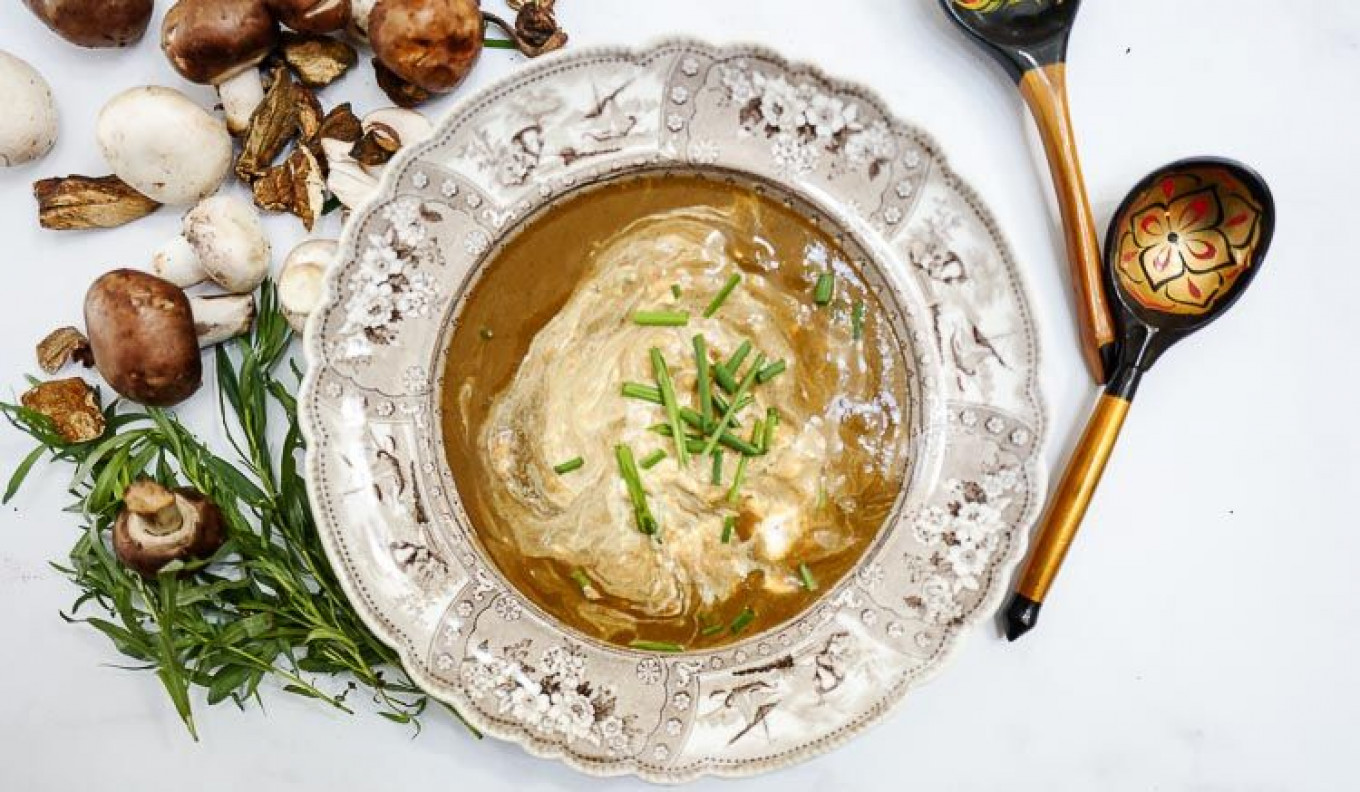
Cream of Mushroom Soup
If you are from America, you might consider cream of mushroom soup an ingredient rather than a finished product, but that does any homemade version of the classic French cream soup a gross injustice. Russians tend not to parlay their mushrooms into this version of soup, but when I score a basket of freshly picked chanterelles, I can never resist the urge to turn some of them into this creamy soup, spiked with Madeira and fresh tarragon. This is an easy recipe, which allows the essential mushroom-y flavors shine through.
I often serve this soup at dinners in shot glasses as a starter, but really, my favorite way to consume this is to pair it with a great episode of something on Netflix, an open-faced sandwich, half a bottle of white wine, and a squishy sofa for the perfect winter evening in. Bliss.
Ingredients
- 1 cup (250 ml) finely minced shallots, or yellow onions (but the shallots make it so much better!)
- 4 oz (125 g) of dried mushrooms (shitake, morels, or chanterelles)
- 2 ¼ lb (1 kilo) of fresh white “champignon” mushrooms, chanterelles, portabella (or a combination) cleaned and finely chopped.
- 1 cup (240 ml) Madeira
- 2 bay leaves
- 1 stick (8 Tbsp or 120 grams) sweet butter
- 1 Tbsp of salt
- 3 quarts (3 liters) mushroom, vegetable, or chicken stock
- 2 bunches tarragon leaves stripped from the woody stems and finely minced. (If tarragon is a challenge, substitute thyme)
- Salt and pepper to taste
- Juice of one lemon
- 1 pint (475 ml) of heavy cream (33%)
- Sour cream for garnish
Instructions
- Submerge the dried mushrooms in 1 quart of boiling water, cover, and set aside for at least 30 minutes to rehydrate.
- Melt the butter in a heavy-bottomed soup pot or Dutch Oven until it bubbles. Add the shallots and sauté until they are golden.
- Add the fresh mushrooms and cook, uncovered for 20 minutes on low heat. The mushrooms are done when they have emitted all of their liquid and reabsorbed it again.
- Strain the rehydrated mushrooms through a fine-mesh sieve or a colander lined with cheese cloth or a clean towel, retaining their liquid. Rinse the mushrooms and chop them roughly. Add the mushrooms and their liquid to the pot.
- Add the cooked shallots, stock, bay leaves, Madeira, salt, and half of the tarragon to the pot. Bring the mixture to a simmer, cover, and simmer over low heat for 30 minutes.
- Remove the Bay leaves, then puree the finished soup in batches in a blender until smooth. Taste and correct seasoning with salt and pepper. If you prefer a rougher texture, strain the soup liquid, and add to ¾ of the solids and puree. Then add the remaining solids.
- At this point, if you want to freeze the soup, cool to room temperature, then decant into freezer-safe containers.
- If serving, return the soup to the pot and set over low heat. Whisk in the lemon juice and taste, adjusting the seasoning with more salt. Slowly whisk in the heavy cream, and heat through, taking care not to overheat and curdle the cream.
- Serve hot, garnished with the remaining chopped tarragon and a swirl of sour cream.
A Message from The Moscow Times:
Dear readers,
We are facing unprecedented challenges. Russia's Prosecutor General's Office has designated The Moscow Times as an "undesirable" organization, criminalizing our work and putting our staff at risk of prosecution. This follows our earlier unjust labeling as a "foreign agent."
These actions are direct attempts to silence independent journalism in Russia. The authorities claim our work "discredits the decisions of the Russian leadership." We see things differently: we strive to provide accurate, unbiased reporting on Russia.
We, the journalists of The Moscow Times, refuse to be silenced. But to continue our work, we need your help.
Your support, no matter how small, makes a world of difference. If you can, please support us monthly starting from just $2. It's quick to set up, and every contribution makes a significant impact.
By supporting The Moscow Times, you're defending open, independent journalism in the face of repression. Thank you for standing with us.
Remind me later.



